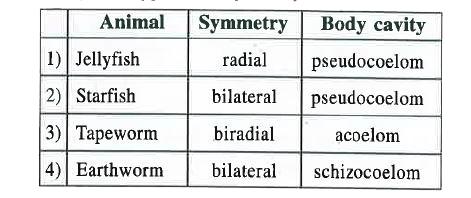In contrast to Annelids, the Platyhelminthes show
(a)
Radial symmetry
(b) Presence of pesudocoel
(c) Bilateral symmetry
(d) Absence of body cavity
Radial symmetry
Presence of pesudocoel
Bilateral symmetry
Absence of body cavity
To solve the question regarding the differences between Annelids and Platyhelminthes, we need to analyze each option provided:
1. Understanding the Groups:
- Platyhelminthes (flatworms) are known to be acoelomate, meaning they do not have a true coelom or body cavity.
- Annelids (segmented worms) are coelomate, which means they possess a true coelom that is lined by mesoderm.
2. Evaluating Each Option:
- (a) Radial symmetry: This is not a characteristic of either group. Both Annelids and Platyhelminthes exhibit bilateral symmetry, so this option is incorrect.
- (b) Presence of pseudocoel: Pseudocoelomates have a body cavity that is not completely lined by mesoderm. Platyhelminthes do not have this; they are acoelomate, so this option is also incorrect.
- (c) Bilateral symmetry: Both Annelids and Platyhelminthes exhibit bilateral symmetry, so this option does not highlight a contrast.
- (d) Absence of body cavity: This is true for Platyhelminthes, as they lack a true coelom, making this option the correct choice.
3. Conclusion: Based on the analysis, the correct answer is (d) Absence of body cavity.
- Platyhelminthes (flatworms) are known to be acoelomate, meaning they do not have a true coelom or body cavity.
- Annelids (segmented worms) are coelomate, which means they possess a true coelom that is lined by mesoderm.
- (a) Radial symmetry: This is not a characteristic of either group. Both Annelids and Platyhelminthes exhibit bilateral symmetry, so this option is incorrect.
- (b) Presence of pseudocoel: Pseudocoelomates have a body cavity that is not completely lined by mesoderm. Platyhelminthes do not have this; they are acoelomate, so this option is also incorrect.
- (c) Bilateral symmetry: Both Annelids and Platyhelminthes exhibit bilateral symmetry, so this option does not highlight a contrast.
- (d) Absence of body cavity: This is true for Platyhelminthes, as they lack a true coelom, making this option the correct choice.
Similar Questions
Bilateral and Radial symmetry
View SolutionIn which of the following phyla, the adult shows radial symmetry while the larva has bilateral symmetry?
View SolutionIn which of the following phyla, the adult shows radial symmetry while the larva has bilateral symmetry?
View SolutionName the phylum in which adults exhibit radial symmetry and larva exhibit bilateral symmetry.
View SolutionThe members of which phylum show radial symmetry ?
View SolutionIn Cassia, symmetry of flower is
(a) Radial
(b) Bilateral
(c) Asymmetric
(d) Irregular
View SolutionIdentify the phylum in which adults exhibit radial symmetry and larva exhibit bilateral symmetry.
View SolutionSelect the correct matching of animal , its symmetry and type of body cavity .

View SolutionOrganism which shows radial symmetry and lack tentacles is
View SolutionEchinoderms show
(a) Bilateral symmetry
(b) Radial symmetry
(c) Asymmetry
(d) None
View Solution
